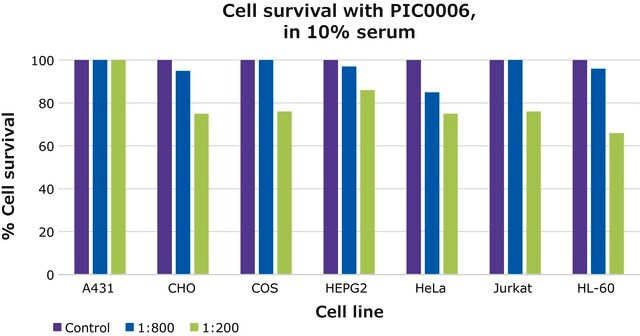539133
Protease Inhibitor Cocktail VI
liquid, for the inhibition of proteases and esterases. This small molecule/inhibitor is primarily used for Protease Inhibitors applications.
Sinónimos:
Protease inhibitor cocktail
About This Item
Productos recomendados
Nombre del producto
Protease Inhibitor Cocktail Set VI, The Protease Inhibitor Cocktail Set VI controls the activity of Protease. This small molecule/inhibitor is primarily used for Protease Inhibitors applications.
form
liquid
manufacturer/tradename
Calbiochem®
storage condition
OK to freeze
shipped in
wet ice
storage temp.
−20°C
General description
This cocktail is provided as a single vial of 1 ml, or as a package of 5 x 1 ml vials. Each vial contains the inhibitors solubilized in DMSO at the following concentrations:
Specificity
Biochem/physiol Actions
Aspartic, cysteine, serine, and metalloproteases as well as aminopeptidases.
Warning
Physical form
Legal Information
signalword
Danger
hcodes
Hazard Classifications
Acute Tox. 4 Oral - Aquatic Acute 1 - Aquatic Chronic 1 - Eye Dam. 1 - Skin Irrit. 2
Storage Class
10 - Combustible liquids
wgk_germany
WGK 3
flash_point_f
188.6 °F
flash_point_c
87 °C
Certificados de análisis (COA)
Busque Certificados de análisis (COA) introduciendo el número de lote del producto. Los números de lote se encuentran en la etiqueta del producto después de las palabras «Lot» o «Batch»
¿Ya tiene este producto?
Encuentre la documentación para los productos que ha comprado recientemente en la Biblioteca de documentos.
Nuestro equipo de científicos tiene experiencia en todas las áreas de investigación: Ciencias de la vida, Ciencia de los materiales, Síntesis química, Cromatografía, Analítica y muchas otras.
Póngase en contacto con el Servicio técnico











